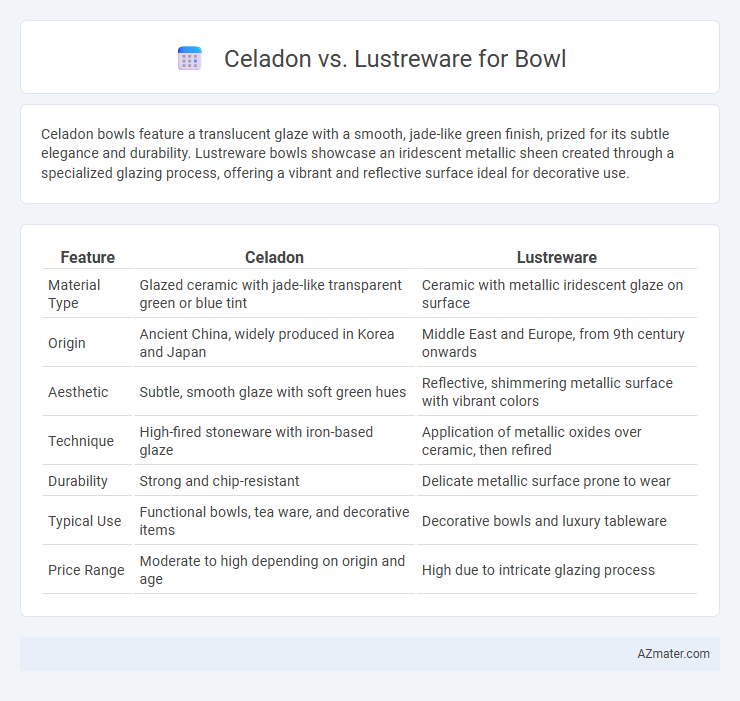Celadon bowls feature a translucent glaze with a smooth, jade-like green finish, prized for its subtle elegance and durability. Lustreware bowls showcase an iridescent metallic sheen created through a specialized glazing process, offering a vibrant and reflective surface ideal for decorative use.
Table of Comparison
| Feature | Celadon | Lustreware |
|---|---|---|
| Material Type | Glazed ceramic with jade-like transparent green or blue tint | Ceramic with metallic iridescent glaze on surface |
| Origin | Ancient China, widely produced in Korea and Japan | Middle East and Europe, from 9th century onwards |
| Aesthetic | Subtle, smooth glaze with soft green hues | Reflective, shimmering metallic surface with vibrant colors |
| Technique | High-fired stoneware with iron-based glaze | Application of metallic oxides over ceramic, then refired |
| Durability | Strong and chip-resistant | Delicate metallic surface prone to wear |
| Typical Use | Functional bowls, tea ware, and decorative items | Decorative bowls and luxury tableware |
| Price Range | Moderate to high depending on origin and age | High due to intricate glazing process |
Introduction to Celadon and Lustreware
Celadon is renowned for its translucent, pale green glaze originating from ancient Chinese pottery, prized for its smooth texture and subtle jade-like finish. Lustreware, distinguished by its iridescent metallic sheen, utilizes metallic oxides to create a reflective surface often in gold, silver, or copper tones, originating from Middle Eastern and European ceramic traditions. Both styles offer unique aesthetic qualities for bowls, with Celadon emphasizing serene elegance and Lustreware showcasing vibrant, reflective artistry.
Historical Background of Celadon
Celadon pottery originated during the Eastern Han Dynasty in China around the 2nd century AD, renowned for its jade-like glaze achieved through iron oxide in the kiln's reduction atmosphere. This technique spread across East Asia, influencing Korean Goryeo celadon and Japanese ceramics, prized for their delicate greenish hues and subtle crackling patterns. Celadon bowls historically symbolized status and elegance, reflecting advanced kiln technology and artistic sophistication in Asian ceramic history.
Origins and Evolution of Lustreware
Lustreware originated in the Middle East during the 9th century, showcasing an iridescent metallic glaze achieved through a complex firing process with metallic oxides, which later spread to Europe, particularly Italy and Spain, during the Renaissance. Celadon, by contrast, began in China over a thousand years ago and is distinguished by its translucent jade-like green glaze without metallic shimmer. Lustreware's evolution involves diverse cultural influences and technological advancements that enhanced its reflective qualities, contrasting with celadon's consistent, muted elegance rooted in ancient Chinese pottery traditions.
Key Characteristics of Celadon Bowls
Celadon bowls are distinguished by their translucent jade-green glaze achieved through iron oxide in a reduction kiln atmosphere, giving them a smooth, glass-like surface with subtle crackle patterns. Their key characteristics include a delicate, pale green to blue-green hue, a thin yet durable ceramic body, and a timeless aesthetic that enhances both functional and decorative uses. Unlike lustreware bowls, which showcase metallic iridescence, celadon emphasizes natural elegance and understated beauty rooted in East Asian ceramic traditions.
Distinctive Features of Lustreware Bowls
Lustreware bowls exhibit a unique iridescent glaze that creates a shimmering, metallic finish, setting them apart from the translucent, jade-green hue characteristic of Celadon. The distinctive rainbow-like luster on Lustreware is achieved through metallic oxides applied in a second firing process, offering a vibrant, reflective surface with a rich color palette ranging from gold to deep purples and blues. This lustrous effect not only enhances aesthetic appeal but also reflects the artisanal craftsmanship and decorative complexity that distinguish Lustreware bowls in antique and collectible ceramics.
Techniques Used in Celadon Production
Celadon production involves a unique technique utilizing iron oxide-rich glaze fired at high temperatures in a reduction kiln, creating its signature translucent greenish-blue finish. The process requires precise control of the kiln atmosphere to reduce oxygen levels, which transforms the glaze's iron oxide and results in the distinctive celadon color. This contrasts with lustreware techniques that add metallic films through additional low-temperature firings to achieve iridescent effects.
Crafting Methods in Lustreware Creation
Lustreware bowls are crafted through a unique technique involving the application of metallic oxides over a previously glazed surface, which is then fired in a reduction kiln to create an iridescent sheen. This method contrasts with Celadon, which achieves its smooth, translucent greenish glaze by firing iron-rich clay in a reduction atmosphere without metallic overlay. Lustreware's complex chemical reactions during firing produce its characteristic shimmering surface, emphasizing a more intricate and time-sensitive process compared to the subtle elegance of Celadon glazing.
Aesthetic Appeal: Celadon vs Lustreware
Celadon bowls feature a smooth, translucent glaze in soft green or blue hues that evokes a tranquil and understated elegance, often prized for its subtle depth and naturalistic beauty. Lustreware bowls, in contrast, display a striking iridescent sheen with metallic or rainbow-like surface colors, offering a vibrant and eye-catching aesthetic perfect for decorative purposes. The choice between celadon and lustreware centers on preference for celadon's classic, serene appeal versus lustreware's bold, reflective brilliance.
Collectors’ Perspectives: Value and Rarity
Celadon bowls are prized by collectors for their translucent jade-green glaze and centuries-old heritage, reflecting ancient Chinese craftsmanship and offering consistent rarity due to limited authentic pieces. Lustreware bowls attract collectors with their iridescent, metallic sheen, often associated with 19th-century European potteries, making rarity dependent on specific manufacturers and unique color variations. The value of celadon bowls typically surpasses lustreware due to historical significance and scarcity of genuine antiques, while lustreware's collectible appeal lies in decorative uniqueness and condition.
Choosing Between Celadon and Lustreware Bowls
When choosing between Celadon and Lustreware bowls, consider the distinct glazing techniques and aesthetic qualities each offers. Celadon bowls feature a translucent, pale green glaze known for its subtle elegance and smooth finish, ideal for understated, classic table settings. Lustreware bowls showcase a metallic, iridescent sheen created through a complex firing process, making them a striking choice for decorative purposes or adding a touch of sophistication to dining experiences.

Infographic: Celadon vs Lustreware for Bowl
 azmater.com
azmater.com